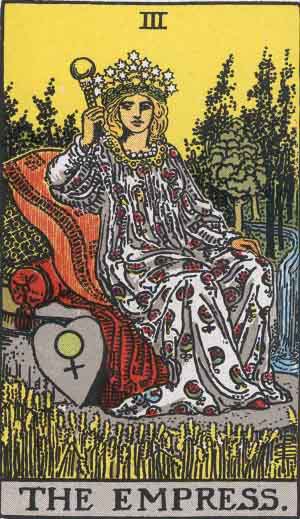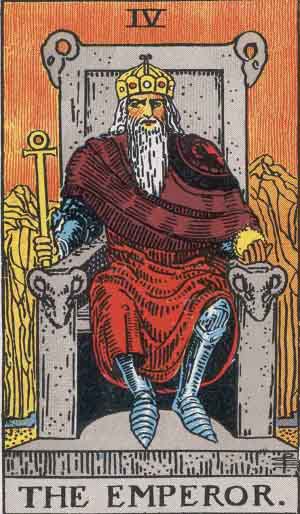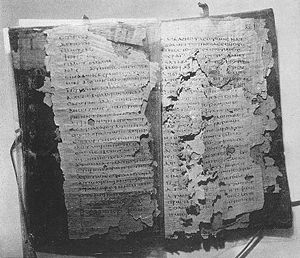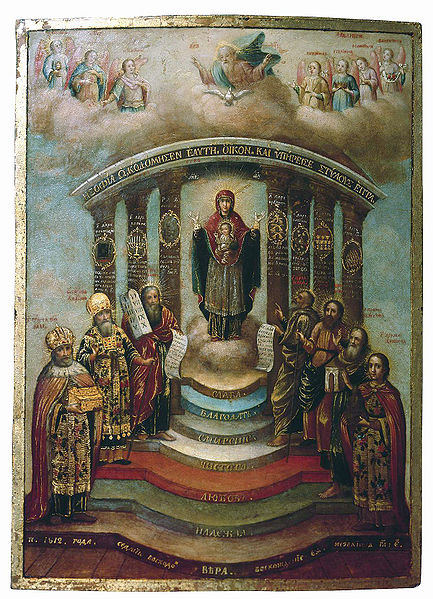|
Welcome to the hidden meaning page, Sophia (Σοφíα, Greek goddess of wisdom)
In order to be whole God needs to reflect all its aspects and that includes both the masculine and feminine. But throughout the ages the feminine has become marginalized and a monotheistic God has been exclusively masculinized. Oh there's some tribute to the feminine through some limited mentions of biblical females, but none are given the status of being the equal aspect of God, all are servants to the one God, none being God itself.
The Greek Arcanum
In the Arcana of the Tarot the Empress card (3rd major arcana card) represents Mother Nature, the mother of all there is and is the passageway between the light and the unknowable darkness. She is the cosmic subconscious out of which all of self-consciousness is born. She also represents the love and approval of one's parents, most often that of the mother (though if hanging upside down this may represent the negative aspect of too much dependency). She is also the giver and taker of life.
The Empress is affiliated with Demeter, Venus, and Isis, the Great Goddess and the Queen of Heaven. The 4th card is the Emperor and represents the Empresses husband and as such reflects the Empress. Together they represent the Yin and Yang of creation—the heart and power behind all that exists. In the mythology it is the Emperor who is born through the door opened by the Empress which is the opposite of the story told in Exodus of the old testament. I wonder how things would have been had this version won out over the other? Together they inform the ego to look beyond its personal self into ones deeper nature.
 
From the Rider-Waite Tarot deck 1909
So, in a world where everything has both a masculine and feminine aspect in relatively equal proportions, we've given our God only half the wisdom of the universe. Curious.
Gnosticism (Greek gnosis: knowledge)

The Gnostic cross
In he biblical text that we find today in the form of the Christian bible does not reinforce the concept of the dual being of God (though there are references to it, see below).
Other traditions not accepted by the greater Christian church, such as Gnosticism, offered another image of God as presented in the codexes found at Nag Hammadi in upper Egypt in 1945.

An example of a Gnostic Text
(Click here to enlarge)
In the Gnostic text found at Nag Hammadi the ideas were considered Christian in substance but also from a Jewish heritage. They differed in that they depicted a monistic God with both masculine and feminine elements. A Gnostic leader, Valentinus, taught that God was indescribable, but could be imagined as a dyad—the primal father, ineffable and deep and the Mother of All, grace and silence and receives the seed of the ineffable Source and gives birth to all the emanations of the divine being.
In the Apocryphon of John (the secret book of John) it tells of John's vision of the Trinity as Father, Mother, and Son.
The Swiss Psychiatrist, Carl Jung, interpreted one of the Gnostic codices as suggesting, from a psychological point-of-view, that the recovery of the Self could only happen if there was an assimilation of the anima (female) into man and the animus (male) in to woman. Here there could be psychological wholeness.
There are those who suggest that this dual image of God as masculine and feminine may have come from the Egyptian and Greek mystery cults that generated the myth of Sophia, the Goddess of Wisdom.
Sophia (Greek: Σοφíα, wisdom)
The Wise Bride of Solomon by Jews (see the Song of Songs in a book of the Hebrew bible*), as the Queen of Wisdom and War (Athena) by Greeks, Isis , the mother of Horus and the first daughter of Geb, god of the Earth, and as the Holy Spirit of Wisdom by Christians. She is known as Chokmah (pronounced HOK-mah) in Hebrew, and Sapientia in Latin.
To the Gnostics, Sophia was the feminine aspect of the Divine (as well as being analogous to the human soul) who came down from God with a special message delivered through the image of Jesus (notice that I use the word "image" because the Gnostics did not necessarily believe that Jesus actually lived as a human). Since Gnosticism downplayed Christ's historicity and resurrection and proclaimed that Christ as Wisdom could be realized individually, it was declared a heresy by the early church.
However, in Eastern Orthodox Christianity Holy Wisdom is understood as the Divine Logos who became incarnate as Jesus Christ. God was seen in this tradition as a trinity of God the Father, Mother and Son.
If it had not been for Sophia, the experience of the noumenous, or spirit, would not have been part of the creation. In the Pistis Sophia (5th or 6th century Gnostic text), Christ is sent from the Godhead in order to bring Sophia back into the fullness of God (Pleroma) she having fallen from the light (though this is refuted by some as ever having happened). Many saw Jesus as embodying Sophia and had come to the world to bring humanity back to Gnosis (knowledge and enlightenment—the meaning and purpose of all things, communication with the mind of God as in a profound spiritual understanding, or transformed consciousness where everything is perceived as a unity—One. This is not unlike the teachings of Buddah.
Essentially, the Greeks saw Sophia as the wisdom aspect of God. Some Christian mystics such as Hildegard of Bingen celebrated Sophia as a cosmic figure representing the wisdom of God and thus eternal.

Sophia (Click hare to enlarge)
The exclusion of Sophia
Because the teachings of Sophia (which were about individual power and reunification with the divine through individual enlightenment) were rooted in everyday living and not in church doctrine, Sophia became problematical and was eventually excluded from the religious formulations of monotheism. God became a man only and the feminine became a servant to this image.
The treatment of women as second-class citizens and as servants to men followed. For all intents and purposes, women have little or no say in the affairs of men, and are most often the most oppressed and abused of people in the world. They are stoned for their transgressions while the men they may have done it with go free. They own no property and in many cultures are considered property themselves. Though they may work as hard as men, they earn less. In many societies, they have no say in even the raising of the children they bore, as well as no say in the societies within which they live and where they have been made dependent on men for their livelihoods. Frequently men have made up rules, or interpreted them from the religious texts that they wrote themselves that are used to control the every day lives of women.
Because of the separation of the feminine from the masculine God, the Goddess has been squashed virtually everywhere. One need only look at the condition of the world to see the consequences of that act.
Sophia as a Dream Image
But the archetypal goddess lives on in our dreams and continues to inform our lives.
In all males there is a feminine aspect of wisdom, insight, intuition, creativity and compassion. A man who cannot, or will not, express this aspect is only half a man and limits his potential greatly. This aspect shows up in the dream as an archetype, in that it is shared by all cultures and people, and is called the anima.
When a Wise Old Woman shows up it frequently means someone of holy and spiritual power. She can be a grandmother, one's mother in old age, a goddess, a queen, princess and any old woman who emanates wisdom. In general she will offer guidance and wisdom consistent with the culture of the dreamer. Most often these figures show up in dreams during periods of great transition. Listening to them can aide in the transition.
The Great Mother figure may visit in many forms, such as the Virgin Mary, a Greek goddess, Sophia, the Earth, or even the dreamer's mother**. These holy people inform and even direct our decisions in life.
Sometimes the Great Mother may come to us to suggest that we cut the dependency between she and us. A man needs to do this in order to become an equal with the feminine power. If he does not do this successfully he may then be into resistance of the feminine and try to dominate it psychologically and in his waking life. Both males and females need to accept the mother as being human in nature. By doing so they then are more able to accept themselves.
Note: In a dream of my own that I titled The Blue Fresco I was invited by a Sophia-like woman to pass beyond her and down a road toward what seemed like a greater understanding, and purpose. Later I worked with a dream where a female animal seemed to offer the same thing. Both dreams were a calling to reconnect the feminine with the world and with me (see Dream Dragon Blog entries Blue Fresco and Σοφíα and A meditation: Reclaiming the powerful child.
There is also a dark aspect to the Sophia image, what some call the Black Madonna (not to be confused with the symbol the Black Nazerene). In an early August Dream Dragon blog I touch on the significance of the the Black Madonna.
***
It has been said by some that the soul in man and woman is the feminine aspect of God, while the Spirit is the masculine. Given that the soul is our consciousness here on Earth, then Spirit is our consciousness beyond the corporeal. Together they form the One.
To hold oneself within the experience of the father-mother God is to experience completeness (Shelem). To deny either aspect is to deny the experience of wholeness. Pretty simple really—the twin flames can be seen as a polarity that separates, or one that unites and we can use our divine given energy for either. But we can only keep the flame going in wholeness because this sacred fire will go out if we snuff one of the twins. All imbalances come from alignment with one side of the scale or the other. Separation ensues and fear and hate, no matter how they are disguised, is the result.
Look into your life to see where you've separated the feminine from the whole. Think about no longer supporting that separation.
If you're a male with females in your dreams, they are only trying to make you complete, don't resist it. The same goes for males in a female's dream. The dream always has your health and wellbeing in mind and all life bends toward wholeness. It is only our fearful ego-selves that get in the way.
Shelem لكي تكتمل
(Adamic for "completeness," (as in wholeness) and to "restore" as spoken by God to Adam/Eve. (Sollus in Latin, Hollus in Greek, integridad in Spanish)
*as an allegorical representation of the relationship of God and Israel, or for Christians, God and the Church, or Christ and the human soul— as husband and wife.
**You can add to that list others such as Isis, Athena, Dianna, Venus, Qwan Yin, Hecate and Demeter.
|